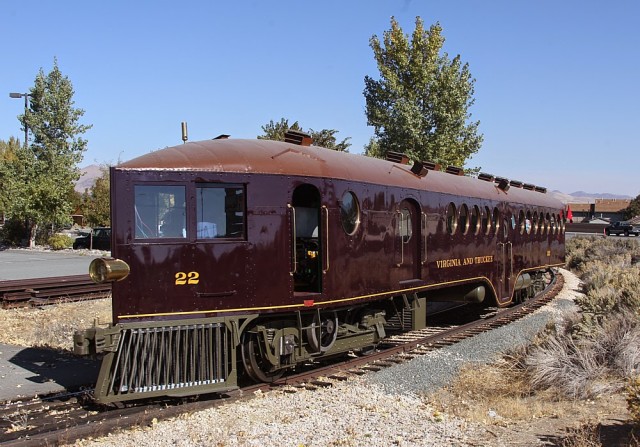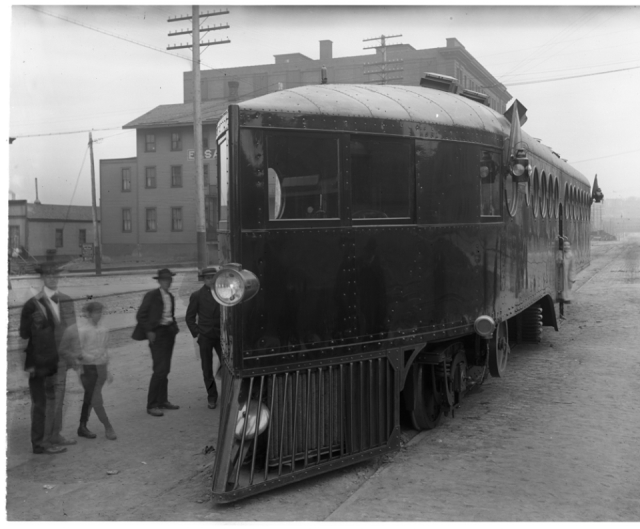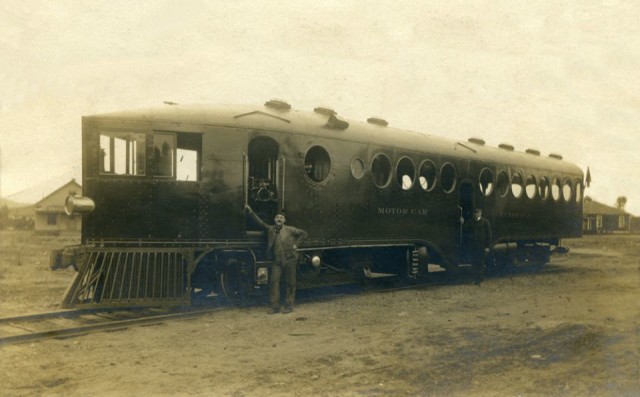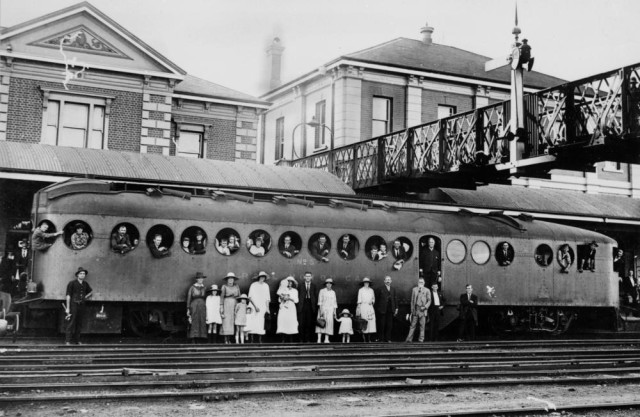
The phrase ‘they don’t build like that anymore’ is a term that is often overused, however, THEY REALLY DON’T BUILD THEM LIKE THAT ANYMORE!!!
The McKeen Railmotor was a 6-cylinder self-propelled railcar. When McKeen Company of Omaha, Nebraska, U.S.A. first unveiled the car in 1905, the McKeen was among the first engines with a gasoline-powered motor. Revisions to the McKeen car led to the modern self-propelled gasoline rail-motor vehicle, and the “contours of the porthole windows, the front-mounted gasoline engines, and other features anticipated the streamline concept. Scroll down for video of a restored McKeen railcar
The vast majority of the cars produced were for E. H. Harriman’s empire of lines (Union Pacific, Southern Pacific and others). Harriman’s death in 1909 lost the company its major sponsor and investor, and Harriman’s successors were less enthusiastic about the McKeen cars.
Many McKeen cars ended up being re-engined with a variety of drive mechanisms — gasoline-mechanical, gasoline-electric, diesel-electric, or even steam power.
Most, although not all, McKeen cars had the distinctive “wind-splitter” pointed aerodynamic front end and rounded tail. The porthole windows were also a McKeen trademark, adopted allegedly for strength after the 7th production car. A dropped central door, as pictured, was also present on the majority of the cars. Two lengths, 55 and 70 feet, were offered; either could be fitted out with a large mail and express area ahead of the center doors, a smaller mail/express area, or the car could be all seats for a maximum capacity of 64 or 105 respectively.
Most of the problems experienced with McKeen cars involved the powerplant and drivetrain. As with many other attempts to bring marine engine technology to the rails, engines that were reliable on the stable platform of a ship when attended to by experienced technicians and operators proved less so when exposed to the vibration, indifferent maintenance and less careful handling they found on the railroad.

Starting the engine was a problem on the early cars; with no independently powered compressor, the compressed-air starting relied on the limited reserves of the car’s reservoirs. There were many reports of cars being started by being pushed or towed by locomotives or even horses, after the compressed air ran out. Later cars, with an independent gasoline-driven compressor which could be hand-started, did not suffer from these problems.
The lack of a reverse gear also caused problems. The engine had to be stopped, the camshaft shifted to a set of reverse cams, and then started in the opposite direction. This was acceptable shipboard, perhaps, but deeply disliked by railroad operators. Accounts exist of engineers’ elaborate schemes for avoiding the necessity to reverse.
The transmission was a common problem; a clutch did not seem to exist which combined the ability to withstand 200 horsepower (150 kW) on a regular basis with the ability to give a smooth start. Clutch failures were commonplace. Competitor GE’s cars used an electric transmission, and that or a hydraulic torque converter have been used on the vast majority of successful internal combustion-engined rail vehicles since.
Many operators found the McKeen car to be lacking in power and traction, the latter unsurprising since only one of four axles was powered.

The McKeen was popular from 1915 through the 1930s throughout the United States, and the cars were featured on the Union Pacific and the Southern Pacific.
Two McKeen railmotors were purchased and delivered to the Victorian Railways in Victoria, Australia in 1911. They served throughout their life as a railmotor they ran the Ballarat to Maryborough and Hamilton to Warrnambool services, and briefly in March and April 1913 on Maryborough to St Arnaud services.
The railmotors had a poor record with many breakdowns, they only lasted around 3 years as railmotors. In 1919 they were de-engined and converted to passenger cars numbered as ABCL 1 & 2 for use on the Altona line until they were scrapped in August 1926.
The Victorian Railways, the government-run system of the state of Victoria in Australia, ordered two McKeen cars in 1911, these being delivered in 1912. These were the only broad-gauge cars, built to the VR gauge of 5 ft 3 in (1,600 mm). They were fitted with buffers andhook and chain couplers, and were built with the rounded-nose body type, rather than knife-nosed. Since VR stations uniformly had car-level platforms, the usual dropped entranceway was instead raised into the roof.
Queensland Railways cars
In 1911, the Queensland Railways of the state of Queensland, Australia ordered a total of five McKeen cars which were delivered in May, 1913. These were to the QR gauge of 3 ft 6 in, and were the only narrow gauge McKeen cars. They were issued running numbers 1 through 5.
Like the Victorian Railways cars, the cars were fitted with the more rounded nose and with buffers; however, the typical McKeen dropped center door was retained to permit easy passenger access without a raised platform. The cars, unlike most, had the same size of wheels on both axles of the lead truck and a chain drive linking them, making all 4 wheels driven.
These cars were approximately 62 ft 4 in long and originally seated 75; this was soon reduced to 69 by dividing the car into a non-smoking section (seating 55) and a smoking section (seating 14). The five cars were based at Woolloongabba for most of their lives, and handled services to the Brisbane suburbs of Corinda and Sunnybank as well as between Manly and Cleveland.

The cars proved no more reliable in Queensland than elsewhere; by 1920 car No.1 was out of service and cars Nos. 2 and 5 were modified as Tourist and Day Inspection cars, with luxury accommodations for 32 passengers. They were still expensive to run, at an estimated double the running costs of a steam-hauled train; the Great Depression finished them off, and the five cars were withdrawn between 1929 and 1931 and scrapped at QR’s Ipswich shops.
An example is preserved at the Nevada State Railroad Museum. This car ran on the Virginia and Truckee Railroad. It has been fully rebuilt. As of September 2010, it runs on special events.
The Nevada State Railroad Museum has restored a full McKeen car, Virginia and Truckee Railway Motor Car 22, a 1910-built 70 foot car.This was one of the last McKeen cars to be still running with its original motor. It made its last run in September 1945, and its body was sold in 1946 for service as a roadside diner, later to be used for a plumbing supply store in Carson City, Nevada.
Donated to the Museum in 1996, its first run was on May 9, 2010, the car’s hundredth anniversary of construction. The original powerplant did not survive, and no other McKeen engines could be located. Consequently, a modern diesel engine was fitted to allow the car to operate up to the original maximum speed.
The fully restored McKeen motorcar was put back into operation on May 9, 2010 right on schedule for its 100th anniversary of its construction. The motorcar is now being used at the Nevada State Railroad Museum In Carson City Nevada for special occasions such as the 4th of July and Nevada Day.
The NSRM also owns the remains of a second McKeen car which was converted into a diesel-electric switching locomotive.
Another McKeen body, construction number 83/103, survives in Anchorage, Alaska. It originally belonged to the San Diego Cuyamaca & Eastern Railroad then was later sold to the Yuma Valley Railroad before arriving in Alaska around 1921, being re-engined and round-nosed in 1924, converted to an unpowered trailer in 1935, and finally retired in the late 1940s after serving in the 714th Railway Battalion during WWII.
Two unpowered McKeen trailers survive; one is a storage shed in St. Helena, California. while the other is at the Illinois Railway museum. You can follow McKeen Motor Car Company Historical Society on Facebook